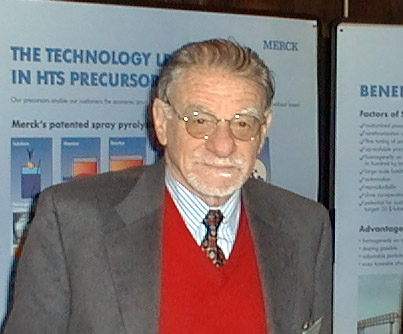- Karl Alexander Müller
Infobox Scientist
name = Karl Alexander Müller
imagesize = 180px
caption = Alex Müller in 2001.
birth_date = Birth date and age|1927|4|20
birth_place =Basel ,Switzerland
nationality =Switzerland
fields =Physics
workplaces = IBM Zürich Research LaboratoryUniversity of Zurich Battelle Memorial Institute
alma_mater =ETH Zürich
known_for =High-temperature superconductivity
awards =Nobel Prize in Physics (1987)Karl Alexander Müller (born
April 20 ,1927 ) is a Swiss physicist andNobel laureate . He received theNobel Prize in Physics in 1987 withJohannes Georg Bednorz for their work in superconductivity in ceramic materials.Biography
Karl Müller was born in
Basel ,Switzerland , on20 April 1927 . His family immediately moved toSalzburg ,Austria , where his father was studying music.He and his mother then moved to
Dornach , nearBasel , to the home of his grandparents. Then they moved toLugano , in the Italian-speaking part ofSwitzerland , where he learned to speak Italian fluently. His mother died when he was 11.In the spring of 1956 he married Ingeborg Marie Louise Winkler. They had a son, Eric, in the summer of 1957, and a daughter, Silvia, in 1959.
Education
After his mother’s death, Müller was sent to school at the Evangelical College in
Schiers , in the eastern part of Switzerland. Here he studied for seven years from 1938 to 1945, obtaining his baccalaureate (Mature). Thus he was a student in aneutral country duringWorld War II . He attended classes which studied the world situation, and participated in discussion groups. This had a profound effect on his career, and life.Müller then enrolled in the Physics and Mathematics Department of the
Swiss Federal Institute of Technology (ETH) inZürich , where he seriously considered studying electrical engineering. He took courses fromWolfgang Pauli , who made a deep impression on him. After receiving hisdiploma , he worked for one year, then returned to his studies, submitting his thesis at the end of 1957.Career
Müller joined the
Battelle Memorial Institute inGeneva , soon becoming the manager of a magnetic resonance group. During this time he became aLecturer at theUniversity of Zürich , which led to his accepting a position at the IBM Zürich Research Laboratory, inRüschlikon , in 1963, where he remained until his retirement. In 1982 he became anIBM Fellow . From 1972 to 1985 Müller was manager of the Physics Groups. He is the Honorary Doctor ofTechnical University of Munich andUniversity of Geneva .Research
For his undergraduate diploma work, Müller studied under Prof. G. Busch. He worked on the
Hall Effect in gray tin, a semimetal.Between his
undergraduate degree and beginning his graduate studies, he worked for one year in the Department of Industrial Research at the ETH on theEidophor large-scale display system.At
IBM his research for almost 15 years centered on SrTiO3 and relatedperovskite compounds. He studied their photochromic properties when doped with various transition-metalion s; their chemical binding, ferroelectric and soft-mode properties; and the critical and multicritical phenomena of their structuralphase transition s.Nobel Prize winning work
In the early 1980s, Müller began searching for substances that would become superconductive at higher temperatures. The highest critical temperature attainable at that time was about 23 K. In 1983 Müller recruited
J. Georg Bednorz toIBM , to help systematically test various oxides. A few recent studies had indicated these materials might superconduct. In 1986 the two succeeded in achieving superconductivity in a barium-lanthanum-copper oxide at a temperature of 35 K. Over the previous 75 years the critical temperature had risen from 11 K in 1911 to 23 K in 1973 where it had remained for 13 years. Thus 35 K was incredibly high by the prevailing standards of superconductivity research.They reported their discovery in the April 1986 issue of ‘’Zeitschrift für Physik’’. [cite journal
author = J. G. Bednorz and K. A. Müller
title = Possible highTc superconductivity in the Ba−La−Cu−O system
journal = Z. Physik, B
volume = 64
year = 1986
pages = 189–193
doi = 10.1007/BF01303701
issue = 1] Before the end of the year,Shoji Tanaka at theUniversity of Tokyo and then Paul Chu at theUniversity of Houston had each independently confirmed their result. A couple of months later Chu went on to achieve superconductivity at the unimaginably high temperature of 93 K.In 1987 Müller and Bednorz were jointly awarded the
Nobel Prize in physics—the shortest time between the discovery and the prize award for any Nobel.ee also
*
Timeline of low-temperature technology References
* [http://nobelprize.org/nobel_prizes/physics/laureates/1987/muller-autobio.html Autobiography posted at the Nobel Prize web site.]
* [http://www.britannica.com/eb/article-9054221/Karl-Alex-Muller Online Encyclopædia Britannica biographical article.]
Wikimedia Foundation. 2010.
